
From TÜV badge to toll sticker - labels in traffic
With stickers on cars, road users want to make a private statement, among other things. Here, the so-called bumper stickers with short slogans hardly differ from warning notices such as "Baby on board". In addition to these labels, there are other important labels in road traffic. These labels prove, for example, that money has been paid or inform government agencies about the technical roadworthiness of vehicles. On the following lines we will inform you about such labels. Not only what they stand for, but also what they mean from a technical point of view.
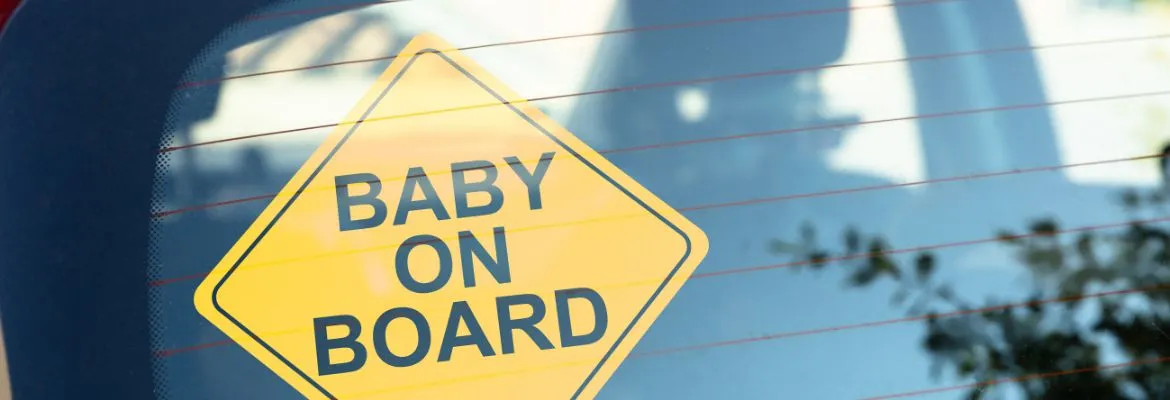
Definition: What official traffic labels must be able to do
Labels and stickers of any kind are exposed to heavy outdoor use:
- Due to the sun's rays, the labels are exposed to UV rays. This stresses both the backing material (especially various plastics) and the printing links used. The former can become brittle, the latter can fade beyond recognition - of course only if the wrong material is chosen.
- The label is outdoors all year round and all day, so it is sometimes subject to large temperature ranges. In direct sunlight, temperatures can sometimes reach triple digits on a surface. In the same way, however, it can be far below 0° during the winter night. This also puts a strain on the entire label and additionally on its adhesive.
- Weather has a physical effect in various ways: Rain, hail, snow. In addition, wind, dust particles moved by the wind and, in the case of labels on vehicles, stone impacts, insects and more.
In summary: Labels for outdoor use in general and for vehicles in particular have to be extra robust to last for several years.
For most official labels, however, this toughness is only basic. Since many of them have the character of official documents, they sometimes have to do much more. Here are a few extracts:
- Forgery protection: For example, holograms, microscopic symbols, elements that only light up under UV light and the like must be integrated.
- Document authenticity: Here, a strong adhesive in combination with a specially designed backing material ensures that these labels cannot be removed without destroying them after they have been applied once. They therefore inevitably tear into several pieces. This is to prevent misuse and make attempts at manipulation easily recognisable.
- Repeatability: In most cases, both the colours and the approved fonts are exactly specified and there must not be even the smallest deviations - even over series of tens of thousands.
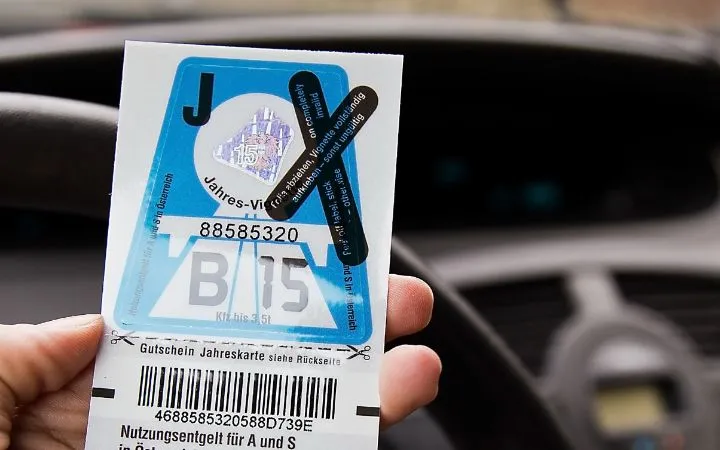
In the case of such labels that are applied externally, there must then even be a further level of toughness: Insensitivity to sometimes quite aggressive cleaning agents, road salt and high-pressure cleaners.
The rare label: number plate stickers
Most likely you know the licence plate - or "number plate" - as an embossed piece of sheet metal. It may well be a carrier for "real" labels and, moreover, black adhesive foils for the lettering, but the number plate itself as a label? Indeed - at least for a small minority of vehicle owners.
There are number plates in the form of stick-on labels. In terms of colours and dimensions, they are indistinguishable from their embossed counterparts.
But is this legal? This is where it gets interesting and a bit tricky from a legal point of view: Section 10 of the Vehicle Registration Ordinance actually prohibits such adhesive number plates due to their contents - actually. In practice, however, it is possible to obtain an exemption through a recognised expert.
This is the case, for example, for special and small-series vehicles where a regular number plate would impair the engine ventilation, for example. Nothing for mass-produced vehicles, but a possible alternative for owners of special vehicles.
Only in the case of e-scooters does the insurance plate even have to be in the form of a sticker - prescribed by law. This has to do with space and weight reasons.

Product Advisor for Labels
Whether it’s a simple roll label or a multi-layered specialty label – I’m your go-to person for questions concerning materials, adhesion, and finishing of labels for the pharmaceutical, cosmetic, food, chemical, and almost any other industry.
"Paper or film? We've got the perfect label!"
I will be happy to help you personally.
The official label: The stamp badge
What is the most important act of the state officials when you register a vehicle on you? It is the affixing of a small, round label to that number plate which (in the case of multi-track vehicles) must be mounted on the front and rear.
Most people know it as a registration sticker, but officially this label is called a stamp sticker. It always has the name and coat of arms of the respective federal state in the middle, surrounded by the name of the registering district or city.
But why is this sticker so important? Quite simply, it is only when it has been affixed to the licence plate (and this in turn to the vehicle) that the official act of registration is legally completed. A licence plate without a stamp sticker (even if everything is legally entered in the vehicle documents) is invalid and you would have to reckon with a fine and further penalties under certain circumstances in the event of a police check.
For this reason, it is theoretically and practically sufficient to decommission the vehicle if this sticker is scratched illegibly with a tool - which is amazingly easy thanks to the special construction of these labels despite their resistance in traffic.
The main inspection sticker and registration sticker, in conjunction with the attached registration plate and an entry in the registration certificate, constitute a so-called "composite document".
The technical label: the MOT sticker
As the owner of a new vehicle, you must bring it in for a general inspection (HU) after three years and every two years thereafter (with the exception of commercially used vehicles, which are inspected annually).
There, the expert checks the vehicle for its technical roadworthiness according to a fixed catalogue. Among other things, the brakes, lighting, chassis and, last but not least, the exhaust gas values must be correct, otherwise the test is deemed to have been failed and the vehicle must be repaired.
For over 60 years now, a small label has proved that this test has been passed - the main inspection sticker. Here are some interesting facts:
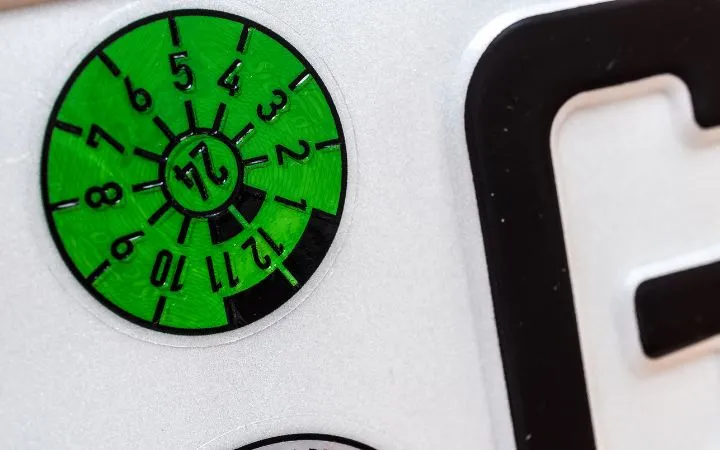
- The (circular) main inspection sticker is always affixed to the rear number plate. If this is the only number plate on single-track vehicles, the stamp sticker is also found there.
- Until 2009, there were still two TÜV stickers: The rear one only showed that the main inspection had been passed, another one (hexagonal), which was mounted at the front, showed that an exhaust emission inspection had been passed. This has been changed. Today, the main inspection sticker is only issued if the exhaust emission test has also been passed. Therefore, there is only one TÜV label.
The sticker is designed in four ways so that law enforcement officers and you can easily see whether the sticker is valid and until when:
- In the centre are the last two digits of the year of the next general inspection.
- The background of the TÜV label is in a colour assigned to that year. There are six of these for as many consecutive years, which are repeated thereafter.
- A wreath with numbers from 1 to 12 runs around the sticker. The number that points upwards (i.e. at the 12 o'clock position) marks the month in which the general inspection must be carried out - the deadline is the last day of the month.
- So that police officers, among others, can see from a distance whether the main inspection deadline is still running, the neighbouring areas between 1, 12 and 11 are marked with thick black bars. Depending on the direction in which they point, the officers can therefore already estimate (together with the colour coding) whether a vehicle in front of them is still OK.
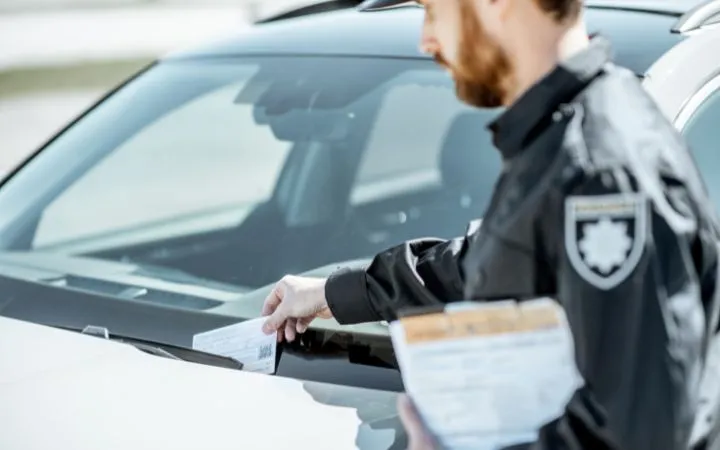
And all this with a label that, by law, may only have a diameter of 35 mm. By the way: If the vehicle is already registered to you, the inspector will affix the sticker to the licence plate. In the case of new vehicles and used vehicles that are being re-registered in your name (e.g. if new licence plates are required), this is done at the registration office after a look at the current TÜV report.
In order to be able to re-register a vehicle, different registration offices require a different length of "remaining MOT". In some cases, a vehicle can be re-registered even if the MOT is due the following month, while other offices require three or even more months of remaining time.
The environmental label: The fine dust sticker
This label is not only the most recent one in this article, it is also one of the few where the side that is visible later is the one that makes contact with the surface to be covered - the fine dust sticker must be stuck to the inside of the windscreen as required.
EU emissions standards have been in place since 1970. For a long time, however, they were only stated in the vehicle documents. From 2006, however, the Federal Republic introduced a law that allowed cities and municipalities to set up special zones - zones in which limit values, especially for nitrogen and particulate matter, can be complied with by banning vehicles from entering them.
This made it necessary to be able to see at a glance whether vehicles in these zones had a correspondingly good exhaust emission standard. The solution to this question was to set up a sticker system, i.e. the (colloquial) environmental or fine dust stickers.
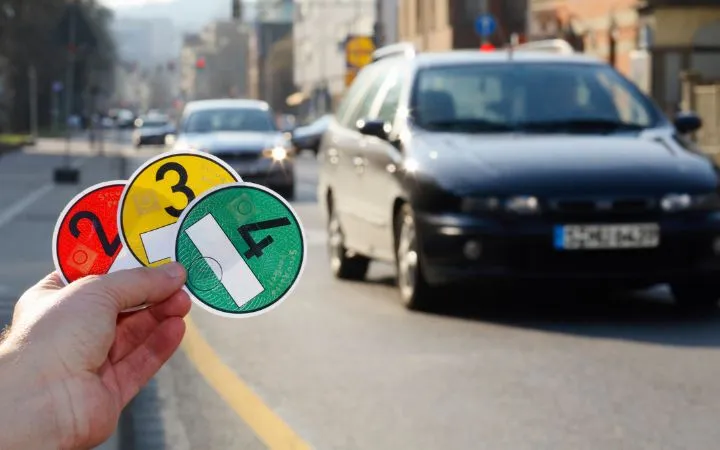
- These exist in three colour variants: red, yellow and green - each with a visible 2, 3 or 4 in the middle. Which vehicle gets which sticker is defined by a complex system of key numbers in the vehicle documents.
- Each sticker must bear the numbers and letters of the registration number in the space provided. The sticker must be attached to the right-hand inside of the windscreen, i.e. on the passenger side. There it must be completely visible from the outside.
The rest of the principle is simple: When entering low emission zones, the corresponding road signs indicate which stickers are allowed to enter. Green stickers are permitted in all of the current 56 environmental zones. Conversely, however, older diesel vehicles with a red sticker, for example, are no longer allowed to enter an environmental zone, nor are vehicles that simply do not have a sticker - even if they could theoretically and practically obtain a sufficient sticker.
For some years now, there has been discussion about a blue sticker that would be subject to even stricter requirements, for example for e-cars. So far, however, it has remained a matter of political discussions and demands.
Vintage cars with H-plates or red 07 plates do not require a sticker, but are still allowed to enter any environmental zone. Furthermore, pure e-cars still need a sticker - but they always get the green one.
The motorway label: The toll sticker
In many countries, motorways and roads similar to motorways can only be used after paying additional tolls. In Germany there is a similar toll (for lorries). However, we are a "special case" in this respect, because we no longer have a corresponding adhesive toll sticker - since everything works digitally via the Toll Collect system.
The situation is different, however, in many European countries around us, such as Austria and Switzerland. There, the toll system works similarly to our TÜV labels, i.e. with colour codes and year numbers. Austria, for example, has used a distinctively different colour every year since 1997 - in 2023, for example, it was a deep purple, whereas in the previous year it was a bright orange.
There are often several selectable periods, so that people passing through have to pay less than residents, for example. However, the vignettes are always designed as labels to be stuck on the vehicle windscreen and are similar to our environmental badge.
Conclusion: Labels are very important in traffic
Labels are information carriers that can be applied quickly and designed in many different ways. This means that they can also serve a wide variety of purposes on the roads - not only of a private nature, but also of a sovereign nature.
FAQ
- Can anyone print the labels mentioned here?
No, not at all. As these are exclusively government-regulated labels, only licensed bodies are allowed to make them. - Is it allowed to paste over old traffic labels with new ones?
As a rule, no. The old MOT sticker, for example, must be removed before a new one can be affixed. - What if you make a mistake with labels that you stick on yourself?
Then it will probably be necessary to obtain a new sticker due to its self-destructive properties when removed. However, if this is done immediately after purchase, there may be goodwill.




